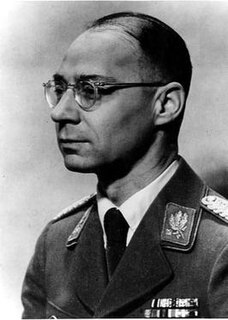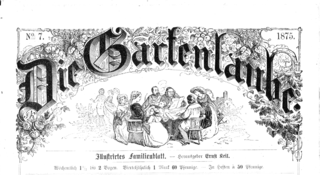Related Research Articles

The Norwegian campaign describes the attempt of the Allies to defend northern Norway coupled with Norwegian forces' resistance to the country's invasion by Nazi Germany in World War II.

The Berliner Zeitung is a daily newspaper based in Berlin, Germany. It was founded in East Germany in 1945 and continued publication after reunification.

Wilhelm Weiss was, in the time of the Third Reich, an SA-Obergruppenführer as well as editor-in-chief of the NSDAP's official newspaper, the Völkischer Beobachter

The Deutsche Zeitung in den Niederlanden was a German-language nationwide newspaper based in Amsterdam, which was published during almost the entire occupation of the Netherlands in World War II from June 5, 1940 to May 5, 1945, the day of the German capitulation in the "Fortress Holland". Its objective was to influence the public opinion in the Netherlands, especially the one of the Germans in this country.

Ernst Josef Albert Weiner was a German SS-Hauptsturmführer during World War II. He was most noted for his role in Operation Blumenpflücken during the occupation of Norway by Nazi Germany.

The Allgemeine Zeitung founded in 1916, is the oldest daily newspaper in Namibia and the only German-language daily in Africa to survive World War I.
Tore Gjelsvik was a Norwegian geologist and polar explorer. He headed the Norwegian Polar Institute from 1960 to 1983, and played an important role in the Norwegian resistance during World War II.

The Quisling regime or Quisling government are common names used to refer to the fascist collaborationist government led by Vidkun Quisling in German-occupied Norway during the Second World War. The official name of the regime from 1 February 1942 until its dissolution in May 1945 was Den nasjonale regjering. Actual executive power was retained by the Reichskommissariat Norwegen, headed by Josef Terboven.

Skorpa prisoner of war camp was a facility built by the Norwegian 6th Division to hold German prisoners of war during the 1940 Norwegian Campaign of the Second World War. Skorpa was the main PoW camp in Northern Norway and held around 500 civilian and military prisoners when it was shut down at the end of the Norwegian Campaign.

Helge Krog was a Norwegian journalist, essayist, theatre and literary critic, translator and playwright.
Fritt Folk was a Norwegian newspaper, published in Oslo. It was the official organ of the fascist party Nasjonal Samling, and came to prominence during the Second World War.
Meldungen aus Norwegen is a series of reports on the situation in occupied Norway during World War II, by the Oslo department of the German Sicherheitspolizei (SiPo) and Sicherheitsdienst (SD). The reports were edited by Georg Wolff and sent to the Reich Security Main Office. They were distributed to German military leaders in Norway and Germany. They were typically structured with a section on the general situation, a section on the resistance movement, and other details.

Die Gartenlaube – Illustriertes Familienblatt was the first successful mass-circulation German newspaper and a forerunner of all modern magazines. It was founded by publisher Ernst Keil and editor Ferdinand Stolle in Leipzig, Kingdom of Saxony in 1853. Their objective was to reach and enlighten the whole family, especially in the German middle classes, with a mixture of current events, essays on the natural sciences, biographical sketches, short stories, poetry, and full-page illustrations.

The Berliner Börsen-Courier was a German left-liberal daily newspaper published from 1868 to 1933. It focused primarily on prices of securities traded on the stock exchanges and securities information about the mortgage market, but also featured news and reports from industry, commerce, politics and culture. It was subtitled: moderne Tageszeitung für alle Gebiete.
Schlesische Arbeiter-Zeitung was a left-wing German language newspaper published from Breslau, Province of Lower Silesia, Weimar Germany between 1919 and 1933.
German American journalism includes newspapers, magazines, and the newer media, with coverage of the reporters, editors, commentators, producers and other key personnel. The German Americans were thoroughly assimilated by the 1920s, and German language publications one by one closed down for lack of readers.

Carlo Otte was a German Nazi administrator.
Naval regions and districts were the official shore establishment of Nazi Germany's Kriegsmarine during World War II. The Kriegsmarine shore establishment was divided into four senior regional commands, who were in turn subordinated to the operational Navy Group commanders who commanded all sea and shore naval forces within a particular geographical region. Within each naval region were several subordinate naval districts who were responsible for all navy shore activities within their area of responsibility, most significantly were the various German ports of occupied Europe.
References
- ↑ Hoser 2010; Sauer 1994, p. 199.
- ↑ Nøkleby 1995.
- 1 2 Sauer 1994, p. 198.
- ↑ Eckhardt 1975, p. 41.
- ↑ Eckhardt 1975, p. 39.
- ↑ Eckhardt 1975, pp. 38, 40.
- ↑ Eckhardt 1975, pp. 43–45.
- ↑ Hale 1965, p. 281.
- ↑ Eckhardt 1975, pp. 37–38.
- ↑ Eckhardt 1975, pp. 5, 45.